Urban Acupuncture To Cure City Ills
Air Date: Week of August 7, 2015
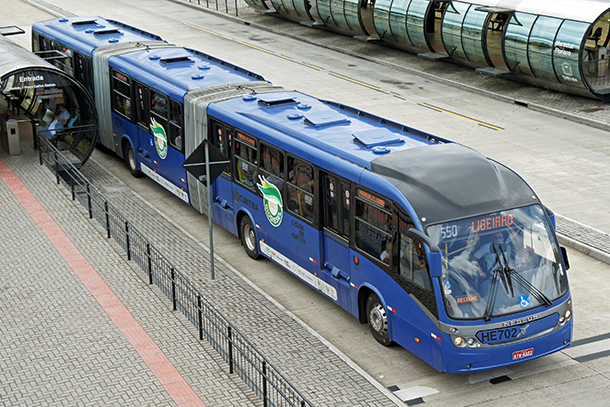
Curitiba is famous for their rapid bus transit system, which moves people like a train at a fraction of the cost. (Photo: mariordo59, Flickr CC BY-SA 2.0)
Curitiba in Brazil has been called “the best planned city in the world.” Host Steve Curwood speaks to Jaime Lerner, the former mayor who revolutionized Curitiba’s public transit system, cleaned up waste and the streets, about the kinds of public engagement that can make cities vibrant again. All it takes, says Lerner, is a pinprick.
Transcript
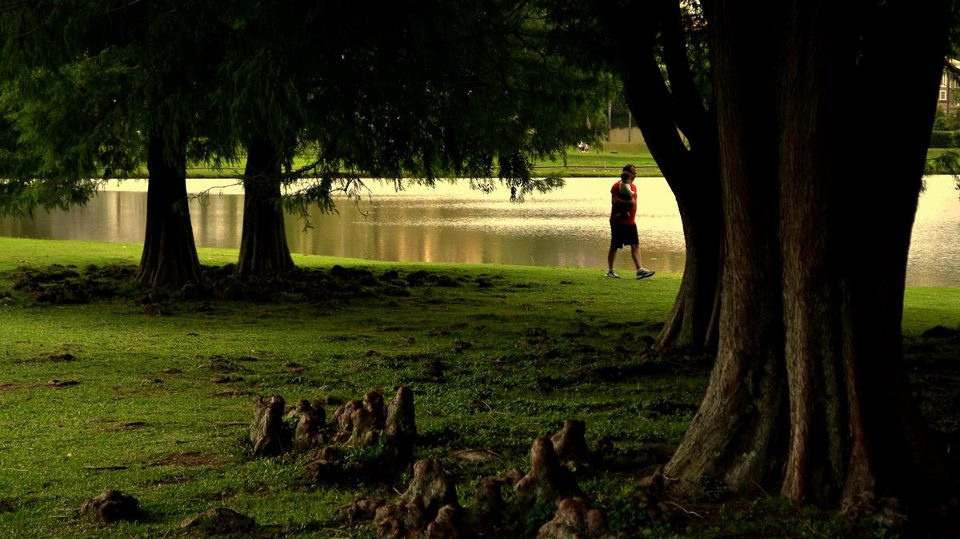
Curitiba has almost 600 square feet of green space per resident. (Photo: Guilherme Scholz Portela; Flickr CC BY-SA 2.0)
CURWOOD: The small Brazilian city of Curitiba has been called the “best planned city in the world.” Most of the credit usually goes to the city’s former mayor, the charismatic architect Jaime Lerner. Lerner went on to be the governor of the state of Paraná. He’s written a new book called Urban Acupuncture, which chronicles the homogenization of cities around the world, and details what everyday citizens can do to breath life back into the urban environment.
LERNER: Begin by drawing your city. Are you a regular customer of the stores and services facing along the street? Congratulations! You are now a citizen.
CURWOOD: Now your book isn’t so much a manual about how to make your city more sustainable. It’s more an ode to those little things that make a city vibrant --pinpricks you call them. So why did you choose to write a book that focusses on these little details?
LERNER: I didn’t want to write a manual, because I wanted to provide the people the sense of what makes a city. I love a thing that I saw in Mexico city in a small square: “Better the grace of imperfection than the perfection without grace”. People they have so many ideas and there’s so many things that can make people happier. I give an example. In my city we had a dentist. At the end of the week, Friday afternoon, he went to his window, he was good clarinet player, and he played a concert.
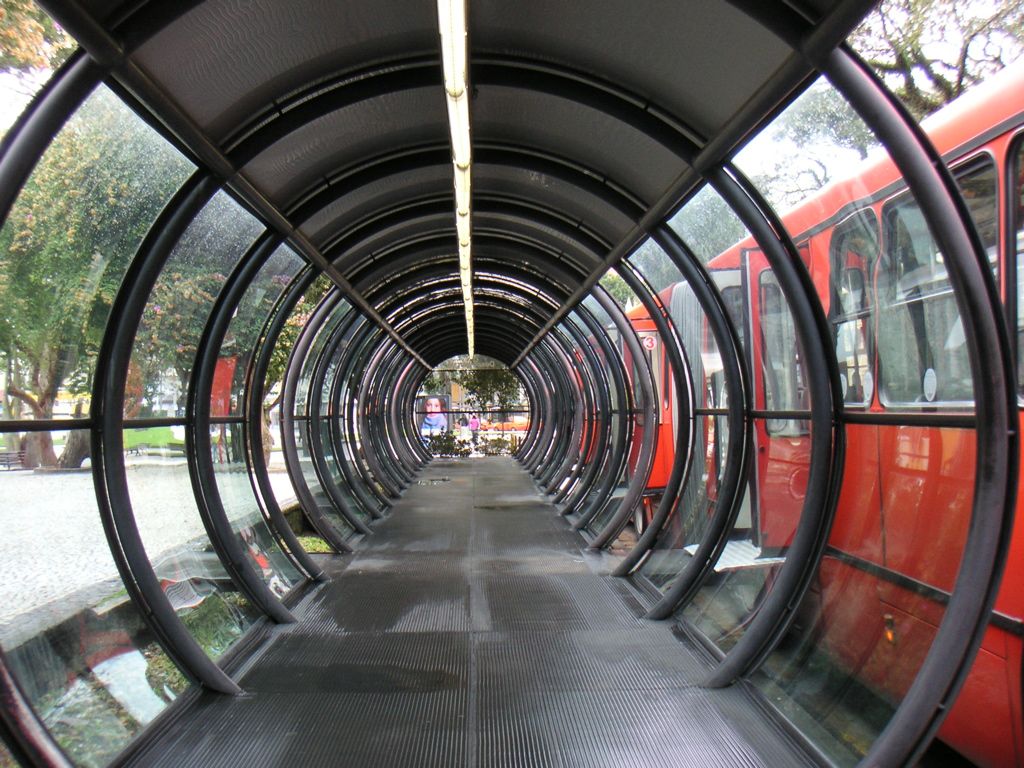
The bus stops in Curitiba look like little subway stations. (Photo: Thomas Hobbs; Flickr CC BY-SA 2.0)
[CLARINET: MICHEL MORAES WITH THE MADEIRA DE VENTO QUINTET.]
And people they knew that every Friday this guy is giving a concert of clarinet. It’s not about works; it’s about feelings, feeling a city.
[CLARINET CONTINUES PLAYING]
LERNER: Sometimes to make a change in a city takes time. The process of planning takes a lot of time time. Sometimes it has to take time, but you can through local interventions, pinpricks, you can start to give a new energy to a city, and you can do it very fast. In my city, when we realized that 75% of carbon emissions are related to the cities, and the half of the problem is the car, we made a big change in public transportation. It was said at that time that every city approaching one million should have a subway. We didn’t have the money for a subway and we started to think “What is really a subway? It is a system of transport that has to have speed, less stops and good frequency. You shouldn’t wait more than one minute or two minutes”. So we started to understand: “Why not on surface?” And in 1974 we started, one line, 50,000 passengers a day.
CURWOOD: That’s a lot of people.
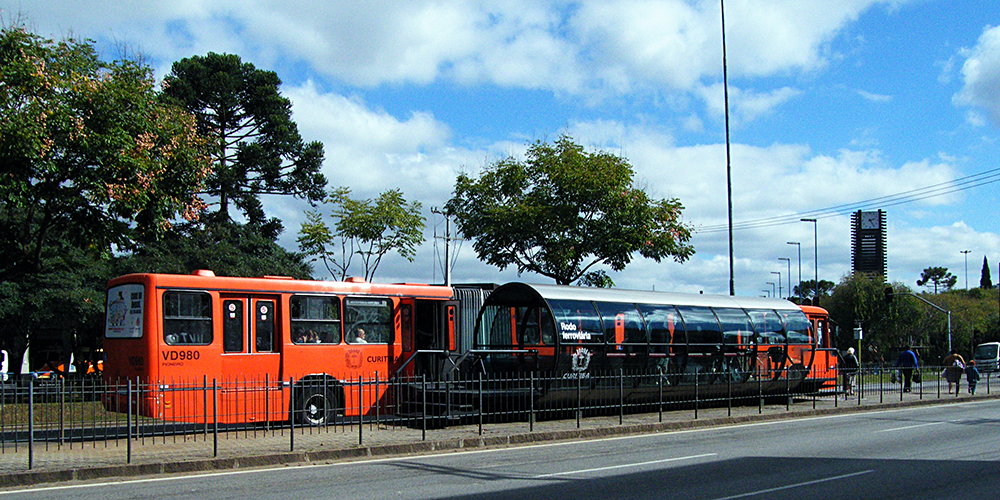
Double-accordion bus at a bus stop in Curitiba, Brazil. (Photo: tortipede; Flickr CC BY-NC-SA 2.0)
LERNER: Yeah and now we are transporting two million, and 600,000 passengers per day, and the subway in London, three million people. And the cost, fifty times less per kilometer. We don't have to wait for money, too much money interferes. You can do it immediately and benefit people immediately.
[SOUNDS OF THE SUBWAY IN CURITIBA]
CURWOOD: Today in Curitiba, there are different buses, including giant ones that can carry 270 people on the exclusive roadways where cars aren’t allowed. Passengers pay their fares as they enter a tubular shelter so when the bus comes it doesn’t have to wait while someone fumbles for change. The Curitiba “speedy bus” is celebrated around the world as a model system for cities trying to do more with less to create attractive and rapid public transit. And to face both congestion and climate change, Jaime Lerner says we have to deal with our addiction to the car.
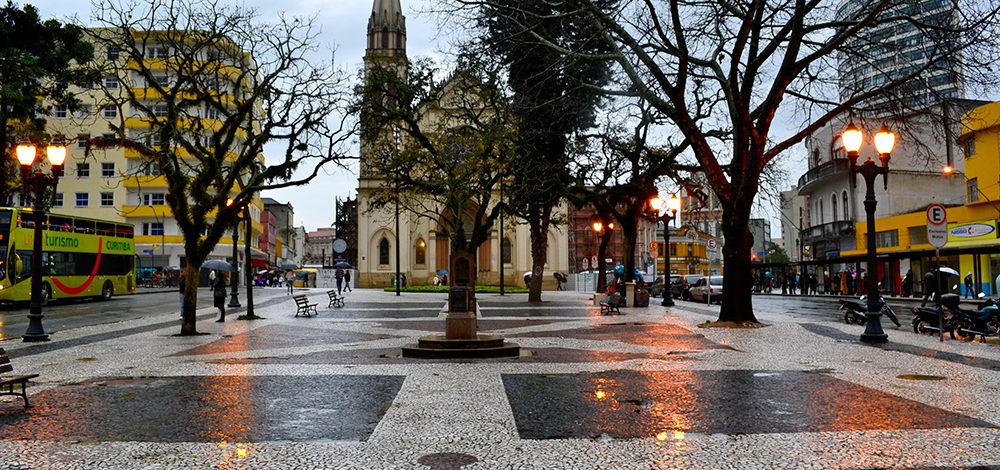
A plaza in Curitiba (Photo: Radamés Manosso; Flickr CC BY-NC-SA 2.0)
LERNER: I wrote a book twenty years ago for teenagers, trying to explain the city, and there was a character Otto the Automobile. So I wote: “Otto is a very egotist guy, a guy who comes to a party, and he only transports one or two or three people, and he came to a party, never wants to leave and he drinks a lot and is sometimes very demanding person because every time more freeways, more freeways”. But the car is become the cigarette of the future.
CURWOOD: The cigarette of the future?
LERNER: Yes, because you know, when it started all over the word to forbid to smoke, nobody expected that reaction. I’m not saying you are not having a car. We still have cars for trips, for leisure, but for daily routine itinerary there’s only one way – public transport.
[BRAZILIAN GUITAR MUSIC; A COMPILATION VIDEO OF SONGS BY LUIZ BONFA]
CUROOD: What does a city need to do in order to have a rich life, to be environmentally responsible, socially fun, politically functional – what does a city need to do to get it right?
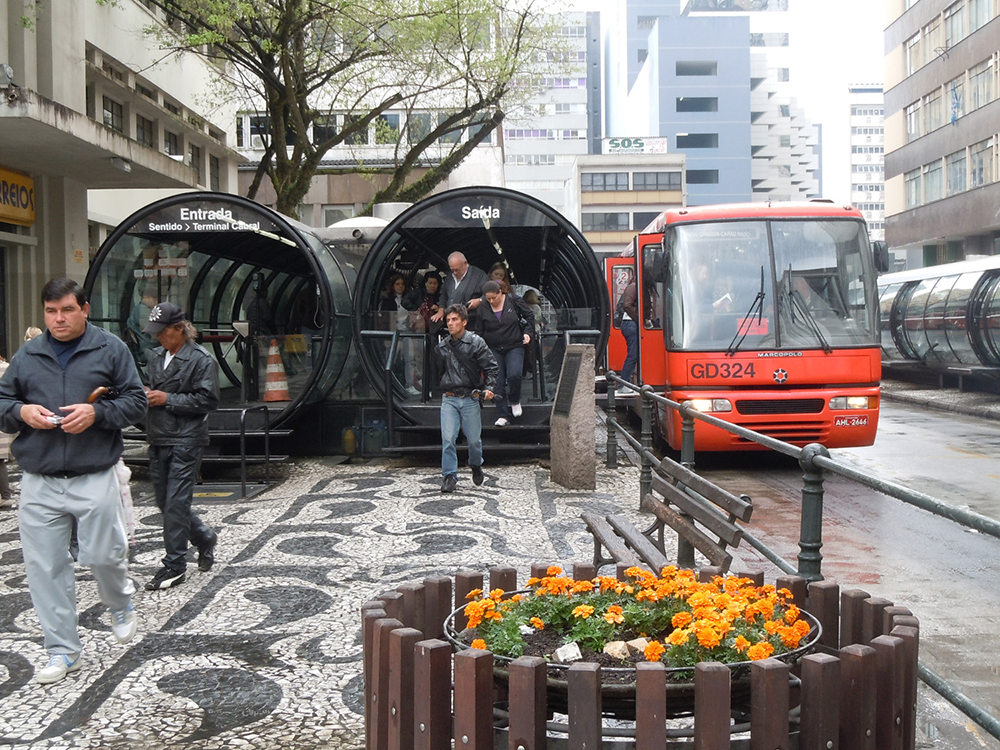
A Curitiba Bus stop. (Photo: whl.travel; Flickr CC BY-NC-SA 2.0)
LERNER: I think a city has to give opportunity to eveything, music, poetry. In my state is 399 municipalities. We didn't have money, for instance, for a small city of 4000 people to have a theater. So what we did, we organized a cultural convoy with 10 buses, recycled buses. One bus was recycled for theater, the other for dance, the other for music, the other for opera, and they travelled all around the state during 5 years. We had an average of 1,500 spectators every night. Or another example; when I was governor we wanted to clean our bays – it’s very costly. What was our solution? It’s a question of co-responsibility. We made an agreement with the fishermen. If the fisherman catches the fish, it belongs to him. If he catches garbage, we buy the garbage. If the day was not good for fishing, they went to catch garbage and the more garbage they catched, the cleaner the bay become, and the cleaner the bay is, the more fish they have. I’m sure every city has such smart solutions.
[GUITAR MUSIC: LUIZ BONFA]
CURWOOD: I asked Jaime Lerner to read a passage from his new book.
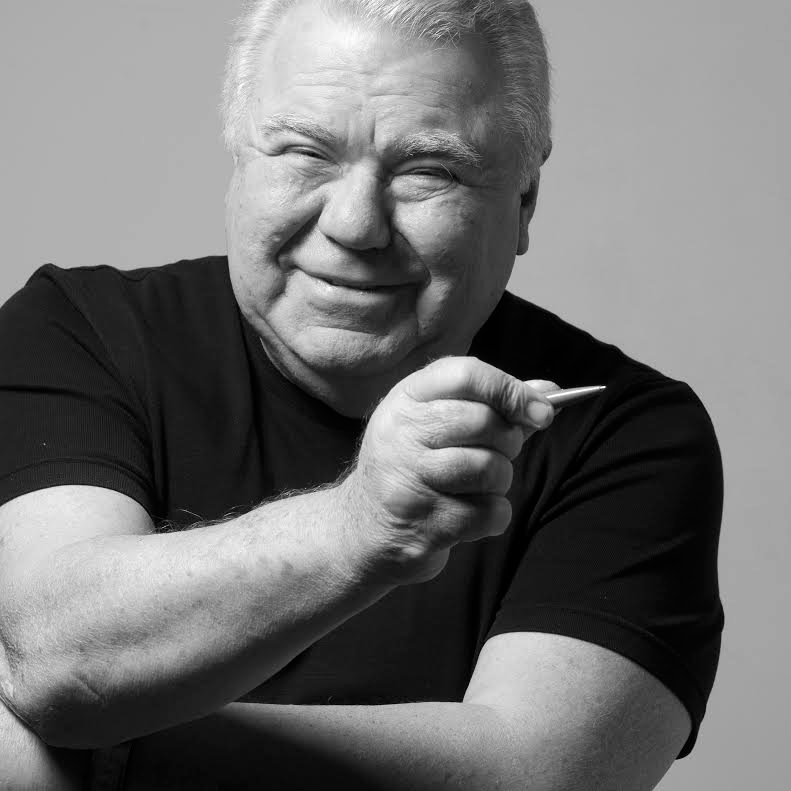
Jaime Lerner, former mayor of Curitiba and author of the book Urban Acupuncture. (Photo: Daniel Katz)
LERNER: The great city must have a silhouette. The color of the sea seen from the terrace of Amanda’s bar in San Juan, the dignity of Via dei Casaoli in Florence, the hazy mornings of my great Curitiba. I think of the Art Nouveau marquee of a building in Paris, in London, the grace of small scale, in New York, where you always have the feeling that you’re just starting out, an athletic blender of ideas where you’re alone in the company of everyone else. In short, every city should have a personality or a melody that flows, because the city that I think of now will be with me forever.
CURWOOD: Jaime Lerner thank you so much. His new book is called Urban Acupuncture, Celebrating Pinpricks of Change that Enrich City Life. Thank you so much!
LERNER: Thank you, thank you.
Links
Living on Earth wants to hear from you!
Living on Earth
62 Calef Highway, Suite 212
Lee, NH 03861
Telephone: 617-287-4121
E-mail: comments@loe.org
Newsletter [Click here]
Donate to Living on Earth!
Living on Earth is an independent media program and relies entirely on contributions from listeners and institutions supporting public service. Please donate now to preserve an independent environmental voice.
NewsletterLiving on Earth offers a weekly delivery of the show's rundown to your mailbox. Sign up for our newsletter today!
 Sailors For The Sea: Be the change you want to sea.
Sailors For The Sea: Be the change you want to sea.
 The Grantham Foundation for the Protection of the Environment: Committed to protecting and improving the health of the global environment.
The Grantham Foundation for the Protection of the Environment: Committed to protecting and improving the health of the global environment.
 Contribute to Living on Earth and receive, as our gift to you, an archival print of one of Mark Seth Lender's extraordinary wildlife photographs. Follow the link to see Mark's current collection of photographs.
Contribute to Living on Earth and receive, as our gift to you, an archival print of one of Mark Seth Lender's extraordinary wildlife photographs. Follow the link to see Mark's current collection of photographs.
 Buy a signed copy of Mark Seth Lender's book Smeagull the Seagull & support Living on Earth
Buy a signed copy of Mark Seth Lender's book Smeagull the Seagull & support Living on Earth

